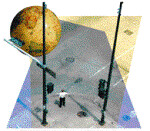How the States Got Their Shapes
 How the States Got Their Shapes by Mark Stein. I read this book several months ago, and have been meaning to mention it here....
How the States Got Their Shapes by Mark Stein. I read this book several months ago, and have been meaning to mention it here....Each of the 51 chapters (it also includes the District of Columbia) discusses some history of each state, focusing primarily on the decisions that were made by kings, settlers and Congress when drawing borders around states.
This book answers some burning questions:
- Why West Virginia has a finger creeping up the side of Pennsylvania
- Why Michigan has an upper peninsula that isn't attached to Michigan
- Why some Hawaiian islands are not Hawaii
- Why Texas and California are so out sized, especially when so many Midwestern states are nearly identical in size
- Was Delaware really necessary?

As a resident of Ohio, I was particularly interested in the story of Connecticut and their claim to lands in the West. Like many of the original thirteen colonies, they claimed land stretching all the way to the Pacific. In most cases, it wasn't that they truly expected to govern that land, but they wanted the right to sell the acreage to settlers. Eventually they were obliged to relinquish they claim to half of Pennsylvania, and much of the territory in Ohio, Indiana and Illinois as Congress organized that area as part of the Northwest Ordinance:

However, Connecticut reserved the right to sell the land in what is now northeast Ohio. It was their "Western Reserve." I had often wondered where the Case Western Reserve University in Cleveland got their name.

My only criticism is the author's arrangement of the chapters. He chose to put the states in alphabetical order, which is fine if you are not reading the whole thing straight through, but want to find and refer to specific states. I would have preferred that he arranged them by regions. So many of the states have common histories of their borders (such as the 49th parallel and the Mason-Dixon Line). If arranged thematically, many of the chapters would not have needed to be so repetitive. Still, this book is a must for map and geography buffs.
#280
Labels: books, connecticut, maryland, ohio, united states





6 Comments:
Great book. i picked it up a few weeks ago and could not put it down till i was finished with it. when i first moved to northeast ohio from upstate ny 5 years ago i was fascinated with the whole western reserve thing and this book seemed to explain it better then any of the ohio history books i found when i moved here.
Interesting that Cleveland, Toledo, and parts of Chicago would have been located in Connecticut had it taken its royal land grants seriously.
I just got this book too and have read most of it. I have to say that fascinating as it is the book contains a number of minor and a few major errors. The most glaring mistake I found is about the origin of the 42nd parallel as an important political boundary. Not only does Stein say it was specified in the 1790 Nootka Conventions between Spain and Britain (it wasn't), but he goes on to say that this particular line of latitude was chosen because it roughly separates the Columbia River watershed from those of the Great Basin and California; and that the Columbia was vital to the British fur trade. But, in 1790 the fur trade had not come close to reaching the Columbia. Plus in 1790 no non-native had explored anywhere near the Columbia watershed's southern limits. In fact, none had even found the mouth of the Columbia. The very existence of the river was more legend than fact. For Stein to claim this as the reason for the 42nd parallel is a major misunderstanding of history. I'm familiar with this particular bit of history and geography, so it caught my attention. Who knows what other major mistakes he made. One of his main ideas is that Congress desired to create states in the west of roughly equal width or height, but he never provides a citation that might allow one to confirm this. I've tried to find evidence of this and have so far failed. Given his misinformation regarding the 42nd parallel I find it hard to believe his width and height theory without additional sources. Nevertheless, it is a fun book, and most of it is clearly true, such as the Western Reserve, the Toledo Strip, etc, etc. Still, I would caution against accepting all the book's claims.
You have some valid concerns. Apparently you are not the only one. The Amazon page for the book has this message:
Updates in Second Edition
12:48 PM PDT, September 17, 2008
I want to thank everyone who pointed out oversights among the multitude of peculiarities in our state borders. When the paperback edition of the How the States Got Their Shapes is released in 2009, it will contain revisions addressing all of these.
Very interesting. I will have to look for this book. I love old maps and use them in a lot of my art work. I just got back from the UK and used an old road map book from the 1940's to create a header for my blog.
Great photos from your trip to London! Thanks.
Post a Comment
Subscribe to Post Comments [Atom]
<< Home